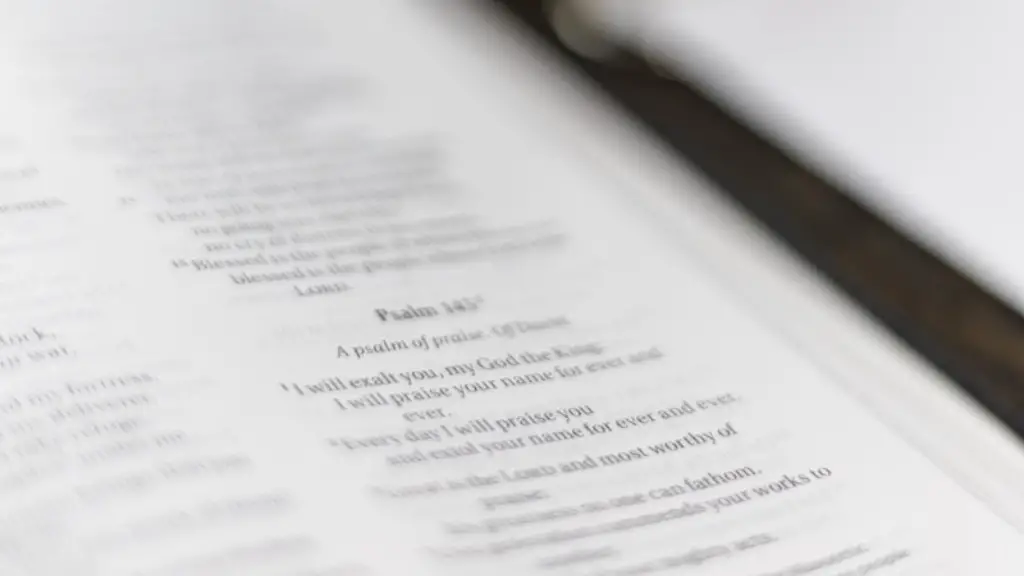Biblical Roots of Homosexuality As Sin
The Bible mentions homosexuality in various parts of its text, leading some to conclude that the practice is a sin. According to the Old Testament, the time of Noah and the destruction of Sodom and Gomorrah, homosexuality is seen as an “abomination,” and a sin deserving of judgment from God. In the New Testament, passages from Romans and Corinthians are used to draw the same conclusion.
God’s initial plan was for humans to procreate and live together as a loving, committed family. Since homosexuality prevents this plan from coming to fruition, it is sometimes considered to be an affront to God’s will. In many Judeo-Christian denominations, the teachings of Jesus are seen as the foundation for moral code. Due to this understanding, these denominations view acts of homosexual love as a violation of God’s commands.
In the Old Testament, there are several passages that pertain to homosexuality, such as Leviticus 18:22, which says, “You shall not lie with a male as with a woman; it is an abomination.” Similarly, Deuteronomy 22:5 states that “No man shall lie with a male as with a woman; it is an abomination.”
The New Testament also references homosexuality multiple times, the most commonly cited being Romans 1:26-27: “For their women exchanged natural relations for those that are contrary to nature; and the men likewise gave up natural relations with women and were consumed with passion for one another, men committing shameless acts with men and receiving in themselves the due penalty for their error.”
In Corinthians 6:9-10, the Bible warns that people who practice homosexuality should not be “inherit the kingdom of God.” Scholars interpret this as a reference to eternal punishment for those who practice homosexuality, although it is unclear if this applies to all persons who engage in such behavior. In modern times, some denominations have begun to interpret the Old Testament passages about homosexuality in a less literal way, concluding that the Bible does not necessarily speak to the morality of modern-day gay and lesbian relationships.
Comparing Different Christian Doctrines on Homosexuality
Different Christian denominations interpret the Bible’s stance on homosexuality differently. Mainstream Protestant denominations generally accept the traditional interpretation of the Bible as condemning homosexuality. The Catholic Church also believes that homosexual orientation is not a sin, but it still considers homosexual acts to be “intrinsically disordered,” and against the teachings of the Church.
More liberal denominations, including non-denominational and mainline protestant churches, often view homosexual acts as not necessarily sinful. Some of these churches have even gone so far as to perform same-sex marriages and ordain openly-gay clergy. Conversely, more conservative churches, such as evangelical congregations, usually take a hardline approach to homosexuality, viewing it as a sin that is in need of repentance.
Despite a clear divide between various religious denominations and their opinions on homosexuality, there is typically agreement among each side that any action should be taken out of love, not judgement or condemnation. Some, however, believe that loving acceptance of those with a homosexual orientation should not necessitate a rejection of the doctrine in which homosexuality is deemed to be sinful.
Does The Bible Condemn Same-Sex Marriage?
The Bible does not directly reference same-sex marriage, as the concept of marriage itself has changed drastically over time. However, some interpret biblical passages in a way that implies such unions would be contrary to biblical teachings. One of the most commonly cited passages is The Book of Leviticus, which states that, “A man shall not take his father’s wife, nor uncover his father’s skirt.” This is often seen as an indication that marriage should take place between a man and a woman, and therefore same-sex marriage should be avoided.
Romans 1: 26-27 is another often cited passage which speaks of “women exchanging natural relations for those contrary to nature” and “men leaving the natural use of women and burning in their lust for one another.” Here, some interpret this as referring to same-sex relationships. This passage is usually seen as a condemnation of homosexual behavior, but does not explicitly speak to the legality of same-sex marriage.
It is important to note, however, that similar passages involving heterosexual relationships are also present in the Bible. If the Bible is to be interpreted literally, it would seem that biblical teachings on marriage apply to both gay and straight couples, in that marriage should only take place between two consenting adults, and must be accompanied by love, understanding, and respect.
The Interpretation of Bible Passages on Homosexuality Over Time
While the Bible’s condemnation of homosexuality is clear, there is debate over how those teachings should be interpreted today, especially considering society’s views on homosexuality have changed drastically since the time of its writing. In the past, homosexuality was viewed as a mental illness and criminalized, but in recent years, more countries have recognized legal rights for homosexual couples. This has led to interpretations of the Bible that view its teachings as pertaining more to the behavior than the orientation of a person.
This is particularly evident in denominations that are more liberal in their approach to homosexuality. These churches view homosexuality as just one behavior among many, with the individual’s orientation and the way that they act on it both being matters of personal choice. Other denominations, however, insist that homosexuality is inherently sinful and should be avoided at all costs.
Modern Approach to The Discussion of Homosexuality in Religions
In more modern times, conversations surrounding homosexuality within the Christian faith have shifted to become more accepting and inclusive. There has been a noticeable move away from the “sin” narrative in regards to homosexuality, to viewing it more as a matter of personal preference and lifestyle. This shift is largely due to society’s (especially in the West) increasingly progressive stance on identity and sexuality. There is still some disagreement among various churches as to whether homosexual relationships should be accepted and condoned within their walls, but the days of outright rejecting same-sex couples are for the most part over.
For those who choose to adopt a more accepting stance, loving the person seeking acceptance may be seen as more important than adhering to a strict interpretation of the Bible. The church may choose to accept them as they are and, in doing so, help them to find the Lord and engage in the church’s activities as a full and accepted member of the faithful.
Other Faiths Attitude to Homosexuality
Many other religions beyond Christianity also have doctrines relating to homosexuality. Islam and most branches of Judaism view homosexual behavior as prohibited, while others such as Buddhism and Taoism take a more inclusive approach. Hinduism does not generally address homosexuality nor has any prohibitions against it. However, the major Hindu sects are all very conservative on the issue, and Hindu society is largely opposed to homosexuality.
In general, the major world religions take a dim view of same-sex relationships. While some groups have modernized their stances to become more tolerant, in many areas, such as India, homosexual acts are still punishable by law. Despite this, many LGBT people have found safety and acceptance in religion and often seek it out from spiritual leaders.
Finding a Balance Between Faith and Homosexuality
The issue of homosexuality often creates a conflict between faith and personal choice. For many, this conflict can be difficult to resolve. This is especially true in the United States and other countries with a strong Christian presence, as the faith-based culture often looks down on same-sex relationships. Yet, despite this, many LGBT people have found solace in the Christian faith, and drawn strength from the lessons of love and acceptance therein.
The key to finding balance between faith and homosexuality lies in acceptance. Instead of focusing on differences and rules, it is important to focus on the underlying messages of love and compassion which are found within all religions. With a proper understanding of these messages, those of all sexual orientations can learn to find peace in the knowledge that God is love, and that our differences should be embraced, not condemned.
Evangelical Churches Shift on Homosexuality
In recent years, a notable shift in attitude towards homosexuality in some evangelical churches has been seen. While homosexuality is still viewed as sinful, there has been an evolution in the way the issue is approached. For example, some churches have decided to focus on the issue of love instead of rule-following, in an effort to make their congregations more welcoming and accepting. This is especially true of those churches located in more progressive areas, where LGBT rights and acceptance is becoming more commonplace.
In many churches, the “hate the sin, love the sinner” approach is gaining ground, allowing LGBT people to be accepted while still maintaining core Christian beliefs. Churches that have embraced this view often engage in programs that support LGBT individuals and can even go as far as performing same-sex ceremonies.
At the end of the day, the question of where the Bible stands on homosexuality is far from black and white. Each individual must wrestle with the Scriptures and decide for themselves how the teachings of the Bible should be applied to their own life. The most important thing is that judgement and condemnation are avoided in favor of acceptance and love.





